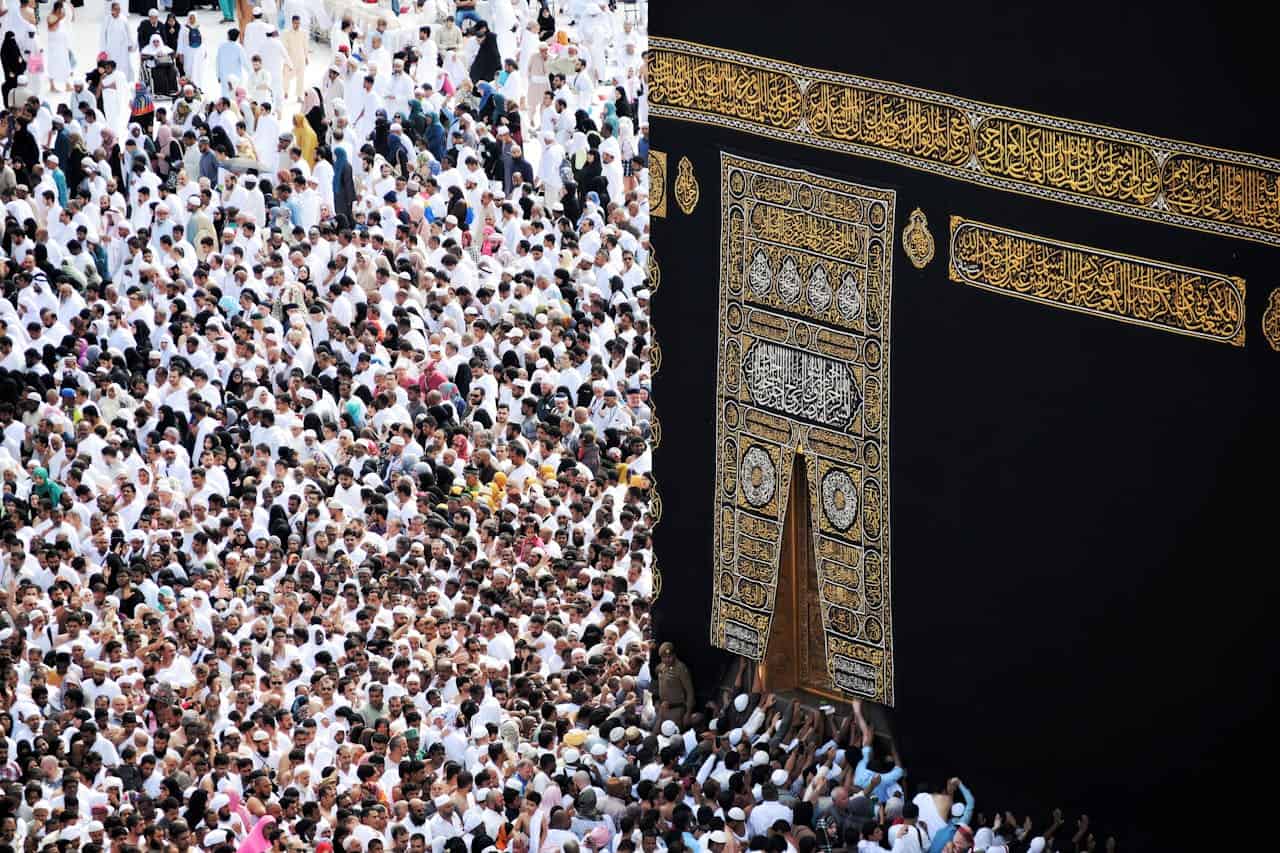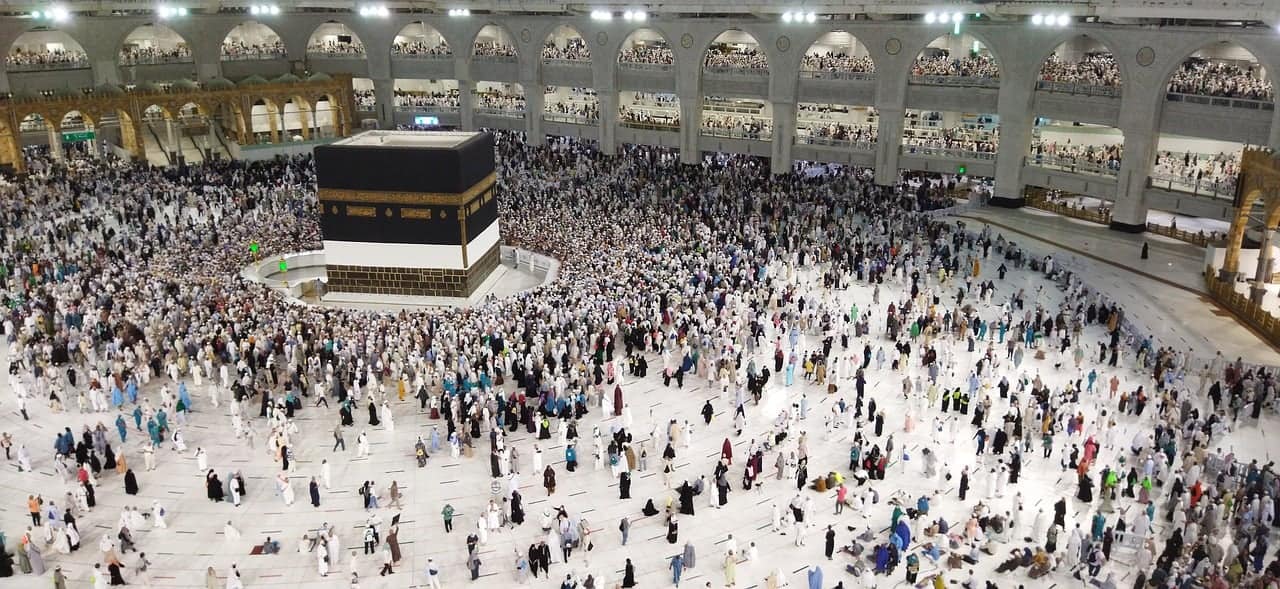Hajj Qiran – Complete Step by Step Guide
In the Name of Allah—the Most Compassionate, Most Merciful.
Hajj Qiran is when a pilgrim performs both Umrah and Hajj in one go.
One Ihram, one intention. No exit in between. The person stays in Ihram from the start of Umrah until the end of Hajj. This method suits those coming from far. Not only does it save time, but it also follows how the Prophet ﷺ completed his pilgrimage.
There’s no break—just a long stretch of Ibadat, movement, and patience.
Some Hajis choose this form because they want to finish both rites without delay. Others do it because their travel plan only allows one visit.
What is Hajj Qiran?
Hajj Qiran is a type of Hajj where the pilgrim enters Ihram with the plan to do both Umrah and Hajj together. There is no pause between them. The person stays in the state of Ihram from start to finish.
This approach means one niyyah, one flow, no exit after Umrah. The pilgrim performs Tawaf al-Qudum, continues with Sa’i, but does not cut hair or change clothing. They stay in Ihram until the days of Hajj are over.
This method is commonly chosen by pilgrims coming from outside Saudi who won’t return for Hajj again.
What Does The Word “Qiran” Mean?
The word Qiran means to join two things. In this case, it means linking Umrah and Hajj into one journey. No pause. No second intention. You make one niyyah and carry both acts all the way.
That’s the base of this method. It’s also referred to as Hajj al-Qiran in many guides and books.
You don’t leave Ihram after Umrah. That state continues until Hajj ends. Unlike Tamattu, where you pause and wear a new Ihram, Qiran keeps the flow. It also includes an animal sacrifice by default.
That’s one thing it shares with Tamattu but not with Ifrad. Ifrad skips the Umrah part. It’s only Hajj. Nothing more.
Full Walkthrough for Hajj Qiran
Hajj Qiran begins with a single intention. The Hajis prepare for both Umrah and Hajj together. They remain in Ihram the entire time. There’s no break in between.
Here’s how to complete this method:
- Begin with the niyyah for Hajj Qiran. Make it clear in your heart that you’re combining both Umrah and Hajj under a single Ihram.
- Say the Talbiyah out loud. This will confirm your intention. Keep saying it throughout your journey.
- Travel toward Makkah while staying in Ihram. No perfume. No cutting hair. Follow the rules of Ihram from this point onward.
- Once you reach Makkah, go straight to the Kaaba and perform Tawaf al-Qudum. These are seven full rounds in the counter-clockwise direction around the Kaaba.
- After that, perform Sa’i between Safa and Marwah. That’s seven trips; each one counts, from one end to the other.
- Do not cut your hair after the Sa’i. Do not exit Ihram. Stay in it. You’re not done yet.
- Wait in Ihram until the days of Hajj This is where Qiran differs from Tamattu.
- On the 8th of Dhul Hijjah, head to Mina. Stay the night there.
- On the 9th, travel to Arafah. This is the heart of the Hajj. Spend the day in prayer and reflection.
- After sunset, move to Muzdalifah. Sleep there and collect pebbles for the next day.
- On the 10th, go to Jamarat and stone the pillar. Then offer your animal sacrifice.
- Shave or trim your hair after that. This marks a partial exit from Ihram.
- Finally, perform Tawaf al-Ifadah and Sa’i once again to complete the Hajj.
This set of steps outlines the combined Hajj method clearly. It will keep you moving in a steady order without breaking the flow between Umrah and Hajj.
What Differs Hajj Qiran and Hajj Tamattu?
Both Hajj Qiran and Hajj Tamattu combine Umrah and Hajj in one journey. That’s where the similarity ends. The difference starts with how the Hajis handle Ihram.
In Qiran, the pilgrim enters Ihram once. The state stays unbroken from start to finish. After Umrah, there is no haircut, no rest, no exit from Ihram. You go straight through till Hajj is done. That means longer time in restriction.
Tamattu works differently. The pilgrim performs Umrah, then exits Ihram. You can rest and get a break. Then you re-enter Ihram for Hajj. It’s two separate states.
One thing both of these types share is that they both require an animal sacrifice. However, Qiran demands more time spent in Ihram and often more patience from the pilgrims.
This difference shapes the experience. For some Hajis, Tamattu offers ease. For others, Qiran brings a better sense of focus. Either method needs planning.
It is necessary that you research which one suits your timeline beforehand.
Three Recognized Forms of Hajj
There are three ways a pilgrim can perform Hajj. Each method of Hajj follows a different structure. The path you take should depend on your entry time, location, and personal choice.
- Hajj Ifrad: This is when a person performs Hajj No Umrah is included. The pilgrim enters Ihram, does all the rituals of Hajj, then exits. No animal sacrifice is needed here. This method is more common among residents of Makkah or those pilgrims who have already done Umrah earlier.
- Hajj Tamattu: In this method, the pilgrim performs Umrah, exits Ihram, rests, and then enters Ihram again for Hajj. Both acts are separate. A break occurs between them. It is usually chosen by Hajis traveling from outside Saudi Arabia who arrive early. Tamattu requires a Qurbani after all the rites are completed.
- Hajj Qiran: The third method is Hajj Qiran, where Umrah and Hajj are performed together, all under one Ihram. The pilgrim is supposed to stay in that state without pause. This path is followed by those who prefer a combined approach from start to end. It also includes an animal sacrifice.
Each Hajj type is valid. Each comes from the practice of early Muslims. The choice completely depends on timing and travel conditions.
Did the Prophet Perform Hajj Qiran?
Yes. Several narrations point to this. The Prophet ﷺ entered Ihram for both Umrah and Hajj together. He did not exit before completing Hajj.
This is also why many scholars encourage Qiran pilgrims to learn this method. It aligns with how the Messenger ﷺ performed it. The phrase Hajj al-Qiran is mentioned in various books and Hajj guides.
Those who follow this path are echoing the Prophet’s own route. It’s a method rooted in early practice. This is what makes it meaningful for many Hajis who choose it.
Number of Tawafs in Hajj Qiran
A Hajj Qiran pilgrim performs multiple rounds of Tawaf. Here’s the breakdown:
- Tawaf al-Qudum (welcome tawaf upon entering Makkah)
- Tawaf al-Ifadah (after the 10th of Dhul Hijjah)
- Optional: Tawaf al-Wada (farewell tawaf when leaving Makkah)
Some scholars say only two are required, but many people do three. The exact count varies depending on the school of thought, but at least two tawafs are necessary.
Frequently Questions About Hajj Qiran
Conclusion
To put it in simple words, Hajj Qiran combines two acts. Umrah and Hajj are done under one Ihram without a break. The person enters with both of these rituals in mind.
They begin with Tawaf al-Qudum, move through the steps of performing Hajj, and then stay in that state until it’s over.
It’s the method the Prophet ﷺ followed. That alone is enough for many. However, it also makes sense for those who don’t want to travel twice. Or those flying in from foreign lands, looking to complete both without delay. You land, start your Ibadat, and finish everything in a single visit.
Wearing Ihram for days isn’t easy. The heat, the waiting, the restrictions. Everything takes a toll. Still, many accept it. Pilgrims read up on the steps. Check off each task.
If you are planning for the Hajj next year, you should follow the Hajj guide like a map.
You’ll find other Hajj Qiran pilgrims in hotels reviewing their checklists, whispering duas, and making sure nothing gets missed.















